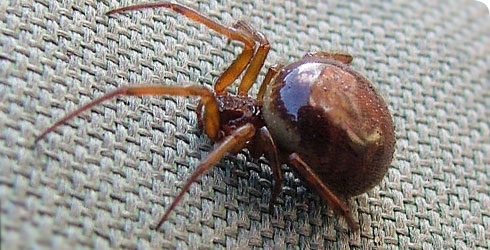Biology
Steatoda nobilis, a species of comb-footed spider, characteristically hang upside down in webs known as tangle webs. Typically, their webs are built high off the ground in a darker corner.
This group of spiders does not specialise on particular prey but are opportunistic and feed on almost any invertebrate that becomes entangled in their webs.
Size
Body length (excluding legs):
- Female: 8–15mm
- Male: 7–10mm
Size (including legs):
- Female: 20–32mm
- Male: 16–22mm
Lifecycle
In general, the life cycle lasts about 1-2 years and the females usually live longer than the smaller males.
The white, spherical egg-sacs are produced at intervals, their number depending on the food supply. Eggs hatch within 2-4 months.
Life Expectancy
Males usually achieve maturity within a single year and die shortly after as they cease to feed once mature.
Females achieve maturity within the second year and depending on environmental conditions and sufficient prey may live into the third year.
Reproduction
Mature and reproductive male spiders are found in summer and autumn, mature females can be found all year round and egg sacks are laid from spring through to autumn.
Dispersal
Local dispersal is achieved through ballooning on silk threads. Longer distance dispersal is aided by transportation of goods by road, rail and the shipping network.
